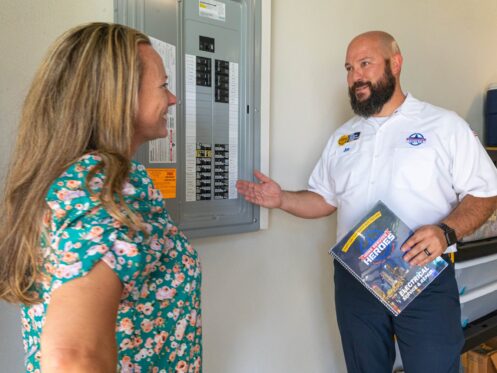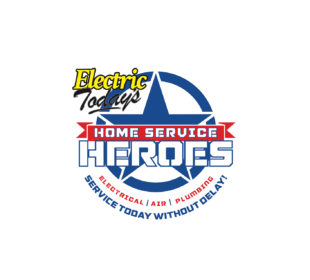Power surges have the potential to cause serious damage to your home and all of your appliances and devices. The only way to fully protect against damage caused by a major power surge is with a whole-home surge protector. In today’s post, we’re going to explain everything you need to know about power surges, how surge protection works and why a whole-home surge protector can be such a great investment.
Internal vs. External Power Surges
A power surge is when more current flows through a circuit or an electrical system than it is designed to handle. Power surges can be extremely dangerous. Whenever too much power flows through a circuit or your home’s electrical system, it causes the wiring to instantly become extremely hot. This can result in the insulation around the wires melting and causing serious damage or potentially causing the wire or any nearby building materials to catch fire. Power surges can also cause serious damage to any electronics you have plugged in or to any of your home’s hard-wired appliances.
There are two different types of power surges—internal and external. An internal power surge is when one of the electrical circuits in your home suddenly draws too much power and gets overloaded, and this can occur for a variety of reasons. For instance, a circuit can get overloaded if you plug too many things into it or because the wiring in an outlet, light switch or any device you have plugged in is damaged and causes a short circuit. There are also times when a malfunctioning appliance or device may suddenly try to draw too much power.
The circuit breakers in your home’s electrical panel are designed to prevent damage to your electrical system and fire hazards that can result from an internal power surge. If too much current ever flows through a circuit for any reason, the circuit breaker will trip so that electricity can no longer flow through the circuit. This should ensure that the power surge doesn’t lead to a fire or damage the wiring in that circuit. However, the power surge can still easily damage anything that is plugged into the circuit, which is why it’s always important to use surge-protector strips for all of your sensitive or expensive electronics.
An external power surge is when the electrical current flowing into your home from the grid is suddenly much higher than your electrical system can handle. This can occur due to issues with the grid, such as a nearby transformer exploding. External power surges can also occur if lightning strikes your home or any other home in your neighborhood or when lightning strikes a nearby power pole.
External power surges are a much more serious problem as they can seriously damage your home’s entire electrical system as well as any appliances and devices that you have plugged in or are hard-wired to the system. Whenever an external power surge occurs, your home’s main circuit breaker will trip almost instantly so that no more current flows into your electrical system. However, the breaker can never trip quickly enough to prevent a huge amount of current from flowing through your entire electrical system and causing serious damage. The only way to prevent this is with a whole-home surge protector.
Differences Between Power Strips, Surge Protectors and Whole-Home Surge Protection
Most homes have numerous power strips or surge protector strips that they use for plugging in things like the TV and entertainment system, computers, etc. A surge protector strip is great for preventing damage to your electronics and other devices caused by an internal power surge. A surge protector strip is essentially a circuit breaker. If a power surge ever overloads the circuit, the surge protector will instantly activate and prevent the power surge from flowing out of the strip and into any devices that are plugged into it.
We would always recommend plugging your TV, stereo system, computers and any other sensitive or expensive electronics into a surge protector strip. However, it is important to understand that not all power strips are surge protectors. Many power strips are only additional outlets that allow you to plug multiple devices into the same outlet but don’t provide any protection against power surges. For this reason, it is important that you look carefully whenever choosing a power strip to ensure that it is actually a surge protector.
Surge protector strips are definitely great for protecting your electronics from potential damage caused by internal power surges. However, no surge protector strip will protect against damage from an external power surge. The amount of current that can flow through your electrical system from an external power surge is far more than what even the best surge protector strip can handle. An external power surge will overload the surge protector strip or fry its components, which means that the excess current will still flow to any devices that are plugged into the strip and usually result in the device’s circuit board and wiring burning out. Whole-home surge protectors can prevent these issues as they will stop the power surge before the excess current can flow into your home.
How Whole-Home Surge Protection Works
The only way to fully protect your home against damage from an external power surge is by installing a whole-home surge protector. This type of device is installed just before the main electrical panel where the electricity flows into the home from the power grid. A whole-home surge protector constantly monitors the electrical current flowing into your home. If the surge protector ever detects that there is excess current flowing through the cable leading to your home, it will instantly activate and disconnect your electrical system from the grid. Since the surge protector is installed before the main electrical panel, it will ensure that an external power surge can never send excess current flowing into the home.
Whenever a whole-home surge protector activates, it instantly redirects all of the electrical current into the home’s grounding rod instead of surging through the electrical system. The grounding rod is driven several feet into the ground outside your home and works to safely disperse all of the electricity into the surrounding soil. If your home doesn’t have surge protection and a power surge causes your main circuit breaker to trip, all of the electricity will also be redirected into the grounding rod.
However, the power will still flow into your electrical panel and throughout your entire electrical system for a short time creating the potential for serious damage and a major fire risk. This isn’t an issue when you have a whole-home surge protector as it will cut off the electricity and direct it into the grounding rod before the power surge actually reaches your home.
Lightning strikes and other external power surges can easily send thousands of volts of electricity surging into your home. Most whole-home surge protectors are rated to protect against surges of up to 20,000 volts. A lightning bolt that directly strikes your home could potentially overload a whole-home surge protector as lighting can sometimes produce millions of volts. Nonetheless, a whole-home surge protector should still be able to protect your electrical system and all of your devices from all but the most extreme power surges. This makes a whole-home surge protector a great investment as it can prevent you from having to pay for costly repairs or needing to replace all of your expensive electronics.
At Home Service Heroes, we specialize in whole-home surge protection, and our team can also take care of all of your other electrical installation and repair needs. We work on both residential and commercial electrical systems, and we also offer a full range of HVAC and plumbing services for customers throughout the Tampa area. For more information on the benefits of whole-home surge protection, give us a call today.

